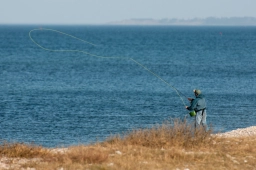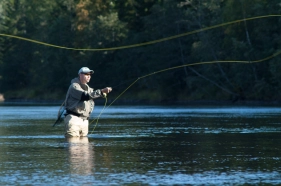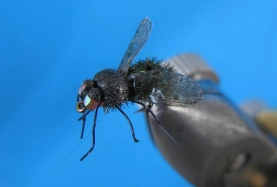This article tries to explain in simple terms what it is to fish with a fly - fly-fish or flyfish.
Fly fishing differs from most fishing in the way that the the fly - the lure or the "bait" - is very lightweight and can't be used to propel the cast. If you are fishing a spinner, plug or a baited hook, you usually have some weight that can pull the line off the reel in the cast.
This is not the case with the fly. The fly is so lightweight, made from a thin hook and some feathers, fur or synthetics, that it can't pull even the lightest fishing line anywhere.
The reason for the fly being light is that it's mostly supposed to represent something small and often lightweight like an insect, a small larva or a small fish or shrimp. Flies can represent all kinds of animals and sometimes other kinds of edible items such as plant seeds or even bread.
Flies can be so light that they float and can look like an insect suspended on the water surface, which is a food item eaten by a lot of fish. Flies can also sink and be made to look and swim like fish and even sink to the bottom and act like a crab or a crayfish.
Casting
In order to cast the lightweight fly lure, the fly-angler uses a fairly thick and heavy line that can be "swung" in the air and carry the fly out over the water.
The casting is done with a series of upside-down pendulum like motions where the rod is tipped back and forth while the fly line follows its tip. By repeating the motion and maybe feeding out more line, the fly-angler can give the line enough forward speed and length to stretch and deliver the fly where the fish is.
Both the rod and the reel used in fly-fishing is made for the purpose and constructed differently than spinning rods. I will return to rods and reels later.
Once a fish is hooked the angler won't normally spool in the line, but keep the line taught by pulling the loose line with the hand not holding the rod. When the fish is under control, the angler might opt to get the spare line on the reel and fight the fish using the reel.
Why call it flies?
Calling it flies and fly-fishing is basically confusing. Even though some flies actually are supposed to look like common flies, the far majority looks like other flying insects like mayflies, sedges, beetles and many more. But in spite of the name flies are also made to resemble underwater animals such as larvae and nymphs of different insects, cress bugs and even worms and leeches. When fly fishing in saltwater, it makes little sense to imitate flying insects since most of the food in the ocean is swimming underwater. So here we imitate fish, shrimps, crabs and many other animals. We still call the flies flies, in spite of them having very little to do with the animal a fly.
Flies can even be made to look like frogs, mice and even snakes as I saw it recently. You will hear terms such as crab flies, ant flies and even mouse flies. And yes, the latter are made to look like a swimming mouse!
And to make things even more confusing, flies are sometimes made to look like nothing natural at all. Like some lures, which are brightly colored and have no natural shape, flies can be all kinds of colors and shapes, which fish seem to like, but seem to have no resemblance with the things they eat.
I will return to different types of flies in later articles.
But why fly fish?
With all that complexity and all the limitations, why would anybody ever want to use a fly rod and fly line rather than a thin line and a lure that can cast with one swoop and go much farther?
First and foremost to be able to fish with small things. Many fish will feed on stuff that is only a fraction of an inch in length, and to imitate that you need something small. Using feathers, synthetics and small hooks to form a fly, we can imitate even the smallest food items like midges, mayflies and small nymphs and larvae. You can also fish something that floats: a dry fly, which would be impossible if the fly had to have weight.
Another reason can be stealth. Using a fly rod you can get the a very gentle presentation of the hook, and can avoid spooking fish off with the splashing of a lure.
Many fly anglers will also argue that fly fishing is more fun. And true enough: if you are not catching, casting with a fly rod might be less boring than casting with a spinning rod, but that's probably a matter of personal taste more than the objective truth.
Imiations and attractors
Some flies look very much like a natural - an insect, a small fish, a crab or a shrimp - while others look like nothing at all, but are colorful blobs without any resemblance to anything living. But both can be very efficient for catching fish. Sometimes the fish will be keyed in on a certain type of edible item in the water like hatching mayflies, anchoves or small crabs running over a sandy bottom. But it also happens that the fish are not in the mood to eat at all, and then you can sometimes provoke them to take a fly. Color, shape or behavior might be the trigger, but the fly doesn't necessarily have to look like something that the fish usually eats.
Hand picked for this article
- Log in to post comments































In my opinion, when
In my opinion, when you do not or cannot propel you fly with a flyrod AND flyline combination, it is not flyfishing.
Methods not using flyrod AND flyline to propel a fly should not be called flyfishing and therefore should be banned from fly only zones and flyfishing competitions.
An interesting read about this is on Günter Feuerstein's website, which i cannot share a link to.
Just go to his site and enjoy his insight on fly fishing.
Cowardly anonymous, because some fisherman (purposely forgot "fly") do not take this to well.
So if you have a lin
So if you have a line and reel but just the leader is being used, such as in some French nymphing, it is still fly fishing. I think it is a problem with legislators and autocrats in states that have restrictive laws. What we call it is of little importants.
So is jig fishing wi
So is jig fishing with Czech rigs fly casting? I would also say no... this can go on endlessly. I was going to get shirts and stickers that said, " real fly fishers use dry flies. " I think by defining what it isn't, it defines what it is.
Mike,
I'm definit
Mike,
I'm definitely not trying to dis other kinds of fishing with a fly - be it Tenkara or using a float. People can discuss that till they are blue in the face for my sake.
The purpose of this article is to explain to the non-fly-fishing angler or reader what fly-fishing is in general, and I don't think I need to draw the whole sectarian discussion of the definition of "proper" fly-fishing into the game.
To me fishing with a fly is basically fly fishing, but I do know people who think that even fishing a weighted fly is sacrilegious and not "real" fly-fishing.
I'm not going there...
Martin
I would also add tha
I would also add that a fair amount of what passes for saltwater flies are lures. There is no fur, no feathers just glue and plastic. You can super glue rubber baits to hooks and fish those with a fly rod. Is that fly fishing? Nope.
Ahhh not so fast. Th
Ahhh not so fast. This debate is going on the Tenkara sites. I would also had fly fishing involves casting a flyline with a fly rod and reel. Tenkara is not fly fishing because there is no flyline. You can cast flies with a spinning rod and a clear bobber but that is also not fly fishing. On many waters Tenkara is not allowed because there is no flyline. Pack up those crappie rods son, 'cause it ain't fly fishing.